
Publisher:
Bonnie King
CONTACT:
Newsroom@Salem-news.com
Advertising:
Adsales@Salem-news.com

~Truth~
~Justice~
~Peace~
TJP
Dec-14-2010 04:28


 TweetFollow @OregonNews
TweetFollow @OregonNews
Snow Buckles and Collapses Roof of Metrodome
Salem-News.comNobody was hurt and it was all recorded on video...
 Courtesy: msfc.com |
(MINNEAPOLIS) - It is nearly surreal; the roof of the Metrodome; as if in slow motion... gave way to the weight of snow early Monday morning.
Workers needed to be pulled off the roof late last night due to safety concerns, officials at the Metrodome report. Around 5:00 a.m. Monday, the roof deflated.
The preliminary assessment is now that at least three panels have sustained some damage; emergency crews of experts are en route to Minneapolis from various locations around the U.S.
Teams and the league are now discussing what to do in order to maintain options to keep games on schedule and in order.
The New York Times reports that the roof's manufacturer; Birdair Inc. in Amherst, N.Y., sent representatives to the scene Monday.
Fabric that will replace the three damaged roof panels was being shipped overnight from other facilities with inflatable roofs; the Pontiac Silverdome in Michigan and the Carrier Dome in Syracuse.
The last time the Metrodome roof deflated was in 1983; due to tears in the panels.
Background information from Metrodome
The road to creating the Metrodome followed a number of twists and turns. The Dome was almost derailed a number of times. We invite you to learn more about the road people traveled on the way to making the Hubert H. Humphrey Metrodome "Minnesota's Rec Room."
History of the Metrodome
The road to creating the Metrodome followed a number of twists and turns. The Dome was almost derailed a number of times. We invite you to learn more about the road people traveled on the way to making the Hubert H. Humphrey Metrodome "Minnesota's Rec Room."
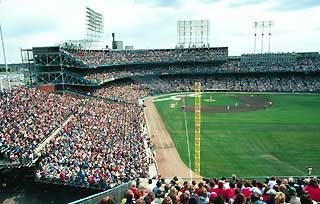 | ||
Metropolitan Stadium was of cantilever design, meaning it had no posts, poles or pillars to hold anything up or obstruct views. | ||
What Was Wrong With Metropolitan Stadium?
Bloomington's Metropolitan Stadium was built for the Minneapolis Millers minor league baseball team in 1956.
It was expanded for major league sports when the Minnesota Twins and Minnesota Vikings came to town in 1961. While the Vikings played games there, the field at its core was a baseball stadium. It only seated 47,000 fans for football, and provided limited fan amenities and team revenues.
The Vikings desired a new state-of-the-art home built for football, and the City of Minneapolis wanted to have that home in their downtown. Others had their eyes on wooing the Vikings, too, including Bloomington, St. Paul, the University of Minnesota, Eagan and Brooklyn Center.
A Rock of Ages By MARC HEQUET
By coincidence, First Bank Minneapolis was opening a branch in the western Minneapolis suburb of Plymouth. Bank officials decided that a more natural landmark could not be found for the new branch than... "Plymouth Rock." Nearly two months after it exhibited a will of its own, the rock became a major exhibit as it was loaded onto two side-by-side flatbed trailers, a railroad car, again onto the flatbed trailers and transported to First Bank Minneapolis's Plymouth branch. And today? The Hubert H. Humphrey Metrodome is complete. Players play. Cheerleaders cheer. Crowds applaud. And the rock breathes a sigh of relief that it may not have to move for another 10,998 years. Mark Hequet is a freelance writer living in St. Paul. Reprinted with permission of MSP Communications. |
Robert Cerny's Futuristic Vision
The idea for a domed stadium was actually conceived in the late 1960s when a Minneapolis architect named Robert Cerny introduced a concept of a domed football stadium in downtown Minneapolis. Over the next decade Cerny's idea became a political football. There was talk of a domed Metropolitan Stadium in Bloomington, a dome at the State Fairgrounds, a dome over Memorial Stadium and several other places in between. In the early 1970s, talk about a new stadium began to get serious. It had to. In 1975 the Minnesota Vikings' and Minnesota Twins' Metropolitan Stadium use agreements were set to expire.
A Move by Minneapolis
With the teams' use agreements about to expire, Minneapolis city leaders saw an opportunity to bring professional sports downtown and perhaps put Robert Cerny's vision to work. In 1972, downtown stadium advocates developed a proposal for a $49.1 million stadium and parking ramp. Nearly 1,000 people showed up at a public hearing in 1973 to roundly shoot it down. Minneapolis Mayor Charles Stenvig promised to vote down the dome proposal (although many said he actually supported the project). He was following the sentiment of many taxpayers who saw it as an unwelcome financial weight that they'd have to bear. Mayor Stenvig followed through on his veto promise. However, the Minneapolis City Council overrode his veto by a vote of 10-3. The proposal then went to the 7-person Board of Estimate and Taxation (which had to approve the bond sale for the project) where things began to get really interesting.
Minneapolis' Move Stalls
The Board of Estimate and Taxation had 7 members, 5 of whom had to vote "yes" for the Metrodome proposal to pass. Mayor Stenvig, who served on the board, had to uphold his city council vote and vote against the proposal. Board member Donald Hanson also indicated he'd vote against it. The remaining five members said they were in support of the proposal. It looked as though the proposal was a done deal. However, it was then discovered that board member Alfred Hum no longer lived in the City of Minneapolis and had moved to Golden Valley.
Mayor Stenvig had to appoint a replacement. All of his nominees were either against the stadium or refused to say how they would vote. The City Council turned down each of Stenvig's nominees. Mayor Stenvig then told the City Council that he would not appoint another member to the board, effectively blocking the stadium vote. Later that year an amendment was passed after a petition drive. It required public approval on all projects over $15 million, which required borrowed money to pay for them.
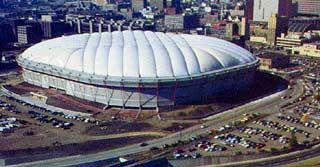 | ||
The Metrodome was completed in 1982. Photo reprinted with permission of MSP Communications. | ||
Task Force Formed
With the stadium proposal stalled in 1973, Minneapolis business leader Harvey Mackay recruited 26 people to serve on a Minneapolis Chamber of Commerce Stadium Task Force. The executive director of the Task Force was Charles Krusell. He played a vital role in the success of the Task Force. Meanwhile, as the issue moved into 1974, Bloomington city leaders were working to make the case for keeping the stadium in their community. The Minneapolis Chamber Stadium Task Force conducted a $25,000 feasibility study. Bloomington held a lavish football weekend for lawmakers and others to see a game, stay at a Bloomington hotel and learn about the issue.
The football weekend and feasibility study didn't move some legislators. "The proposal for a new multi-purpose stadium is dead," said St. Paul Senator John Chenoweth, "and the reason is that taxpayers are unwilling to sign a blank check. We're interested in having the Vikings stay, but the question is: what is the price?"
In April of 1975, Governor Wendell Anderson said that he was convinced that the Twins and Vikings would leave the state without passage of stadium legislation.
The Vikings' general manager-vice president Mike Lynn wanted a new stadium -- not a shared stadium with the Gophers or a renovated stadium. "The idea of playing in the college stadium is even more repugnant than playing in Metropolitan Stadium," Lynn said.
The No-Site Bill
After much wrangling in the 1975, 1976 and 1977 legislative sessions, a no-site bill -- the idea of Rep. Al Patton (DFL-Sartell) -- was finally passed in 1977. The bill created a seven-member citizens commission appointed by Governor Rudy Perpich. This commission selected the stadium site and design. A revenue bonding package was developed to finance the stadium. If revenue streams to support the bonds were not sufficient to retire the bonds, a two-percent metropolitan area liquor tax would be imposed to generate additional bond revenues. The commission was held to certain financial parameters:
It could spend up to $37.5 million if it chose to build a new football stadium in Bloomington and improve Metropolitan Stadium for baseball.
It could spend up to $25 million if it chose to remodel Metropolitan Stadium as a multi-purpose stadium.
And it could spend no more than $55 million if it decided to build a new domed stadium anywhere else. In effect, if any other city than Bloomington wanted the stadium, it would have to provide for a way to get the land at no cost.
Minneapolis Makes its Move
Following passage of the bill, the Minneapolis Chamber formed the Stadium Site Task Force, chaired by John Cowles, Jr., president of the Minneapolis Star and Tribune Company. It called for the creation of the Industry Square Development Corporation, which would provide the City of Minneapolis with a locally owned development company. In exchange for the stadium land, the company would receive exclusive development rights in the Industry Square area. The Minneapolis City Council approved the plan. In late 1978, the Industry Square Development Corporation obtained $14.5 million from Twin Cities companies to purchase the land where the Metrodome now stands. Minneapolis became a competitor in the battle to be selected as the stadium site.
The New Stadium Commission
The newly formed Metropolitan Sports Facilities Commission was designed to be geographically diverse. Two of the seven commissioners had to reside outside the Twin Cities. One each was to come from Minneapolis, Saint Paul, the southern metropolitan suburban area and the northern suburban area. The chair had to reside outside of the Twin Cities. The commission's appointees in 1977 were:
Don Brutger -- A resident of Saint Cloud, Brutger served as the Commission's chair and was the owner of a St. Cloud construction company and numerous other business holdings.
Solveig Premack -- A Minneapolis resident, Premack served as vice chair of the Capitol Area Architectural Planning Board.
Richard Radman -- A Saint Paul appointee, Radman was vice president of the Minnesota AFL-CIO and secretary and business representative of the Saint Paul Building and Construction Trades Council.
Marion Kennon -- A resident of Edina, Kennon was an elementary school teacher at Breck.
Ron Gornick -- A resident of Chisholm, Gornick owned a Chisholm service station and motel. He had also served on Governor Wendell Anderson's Small Business Task Force.
Josephine Nunn -- She was mayor of Champlin and a member of the Metropolitan Council's advisory committee on municipalities.
Kelly Gage -- A lawyer from Mankato, Gage was a former state representative from Blue Earth County.
Donald Poss served as the commission's first executive director. He had been the Brooklyn Center city manager.
Selecting the Stadium Site
The commission received eight proposals for a stadium. Two came from Minneapolis. One came from Bloomington and another from Saint Paul. Then there was the "Midway" area proposal for a site between Saint Paul and Minneapolis. Other entries came from Brooklyn Center, Coon Rapids, and Eagan. In the end, the choice came down to Minneapolis and Bloomington. The commission could either build a stadium on the site in Bloomington or sell that land and build on the Minneapolis site.
The vote passed 4-3 to make the Metrodome a reality.
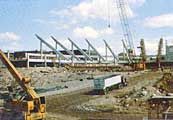
|
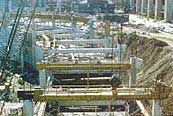
|
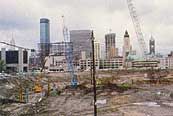 |
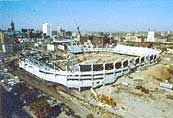 |
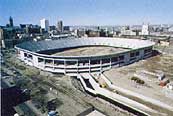 |
Designing and Building the Metrodome
Construction of the Metrodome in downtown Minneapolis started in December of 1979. The commission wanted the Metrodome to be an "austere but a quality and aesthetically pleasing structure."
The design team included Skidmore, Owings & Merrill (SOM) and Minneapolis-based Setter, Leach & Lindstrom, Inc. SOM, one of the world's largest architectural firms, had designed the Pillsbury Center, Lutheran Brotherhood headquarters and Minneapolis City Center. Setter, Leach & Lindstrom, Inc., has done a number of major Twin Cities projects, including design of the Fairview-St. Mary's Medical Office Building, the Minneapolis Convention Center and the James J. Hill House restoration. New York-based Geiger Berger Associates designed the Metrodome's roof.
Overseeing Metrodome construction was Construction Management Services of Minneapolis and Detroit-based Barton-Malow. Approximately 80 companies were awarded contracts to participate in the construction of the Metrodome, with most of the labor from Minnesota construction workers. On January 2, 1980, shortly after excavation had started, bulldozers encountered an immovable force - a 250,000-pound granite rock, believed to have been there for about 11,000 years. The rock was eventually moved to a bank in Plymouth, Minn., dubbed "Plymouth Rock" and construction continued.
The Dome was inflated on October 2, 1981 and the stadium was completed in April 1982. The project was completed on time and unlike many new stadiums today -- under budget. The final price came in at $55 million.
The Day the Dome Went Down By MARC HEQUET The stadium's roof, after partially collapsing the day before, completely deflated under the weight of 10.2 inches of heavy, wet snow. Stadium authorities blamed the deflation on a large rip in the roof, caused by a puncture in the panel of the fabric on the north side of the stadium. There were no injuries, and the roof was repaired and reinflated four days later, before the next snow could have done more serious damage. The rip was caused when a bolt snapped, bending a piece of steel which slashed through the fabric roof. The roof is kept in place by air pressure from up to 20 fans inside the stadium, and the dome collapsed when air escaped through the hole. News of the deflation, along with the heaviest Twin Cities snowfall since Nov. 17, 1978, was carried on all three network evening news shows and was featured at halftime and before games the following Sunday and Monday on various National Football League telecasts. Marc Hequet is a freelance writer living in St. Paul. Reprinted with permission of MSP Communications. |
The First Years at the Metrodome
Forty-eight days after the Dome was inflated, a major storm dumped more than 10 inches of heavy wet snow on the Dome. The weight of the snow caused the roof to partially deflate. A rip in the roof was caused when a bolt snapped, leaving a sharp piece of steel to tear through the fabric. Air escaped through the tear and the Dome deflated. The rip was repaired and the Dome was re-inflated within four days. The fabric roof has torn a few times since then, but it has only postponed an event or game once - in April of 1983, a baseball game between the Minnesota Twins and California.
The first Twins regular season game at the Metrodome was April 6, 1982 versus the Seattle Mariners. The Twins fell to the Mariners 11-7. The first Vikings regular-season home game was September 12, 1982, when the Vikings beat the Tampa Bay Buccaneers 17-10.
Honoring Hubert H. Humphrey
Hubert Humphrey, former Minneapolis Mayor, U.S. Senator and U.S. Vice President, loved Minnesota. He was a big sports fan and rooted for the Vikings and Twins at every chance. Because of his dedication to the state and to teamwork, the Metrodome was named in his honor -- The Hubert H. Humphrey Metrodome.
Celebrating 20 Years as Minnesota's Rec Room
The Metrodome, as the country's only public stadium that does not rely on a continuing tax subsidy to finance operations, maintenance or debt payments, has truly established itself as Minnesota's Rec Room during the past 20 years.
The Metrodome is the only stadium in the world to have hosted all of the following: the NFL Super Bowl (1992), Major League Baseball's All-Star Game (1985), two World Series (1987, 1991), and the Final Four of the NCAA Division I Men's Basketball Championship (1992, 2001).
Out of more than 300 event days per year at the Metrodome, less than 100 feature professional or major college sports. The rest of the event days are used by high schools and colleges, concerts, community activities and other events.
The Metrodome hosts boys' and girls' high schools from throughout Minnesota for athletic and other events and small college athletic competitions.
More than half a million people have come to the Metrodome to see concerts by major performers such as Pink Floyd, Paul McCartney, Guns N' Roses, Faith No More, Metallica, The Rolling Stones, Bob Dylan, Tom Petty and The Grateful Dead.
The Metrodome is the only major facility in Minnesota big enough to host major motorsports events.
The Metrodome draws more than 4,000 runners and 30,000 inline skaters per year.
Sources:
Busch, Duffy. The Hubert H. Humphrey Metrodome, Souvenir Edition of the Greater Minneapolis Magazine. Minneapolis: Prime Publications, 1982
Klobuchar, Amy. Uncovering the Dome. Prospect Heights: Waveland Press, Inc., 1982
Special thanks to msfc.com for information in this article.
Articles for December 13, 2010 | Articles for December 14, 2010 | Articles for December 15, 2010


googlec507860f6901db00.html



Terms of Service | Privacy Policy
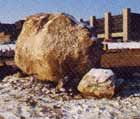 So, the rock resisted all attempts to dislodge it, move it, crush it, blast it. In short, it had the excavators between a rock and... well, you get the idea. Meanwhile, it captured local public sentiment and substantial media attention.
So, the rock resisted all attempts to dislodge it, move it, crush it, blast it. In short, it had the excavators between a rock and... well, you get the idea. Meanwhile, it captured local public sentiment and substantial media attention.
All comments and messages are approved by people and self promotional links or unacceptable comments are denied.
[Return to Top]
©2025 Salem-News.com. All opinions expressed in this article are those of the author and do not necessarily reflect those of Salem-News.com.